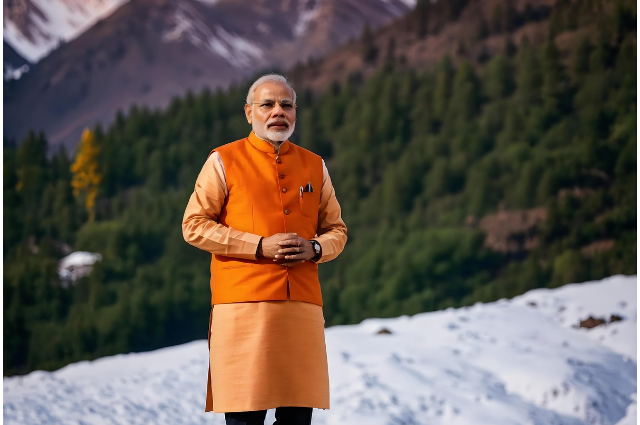
The President of the United States of America has once again found himself in the limelight, not for his “said” role in mediating the ceasefire between India and Pakistan, but for receiving a polite declination of his extended invitation to Prime Minister Narendra Modi.
The invitation was extended to the Prime Minister during his recent visit to Canada to attend the G7 Summit. As the US President had departed early owing to the “rising tensions in the Middle East”, he could not hold a formal meeting with the Indian premier.
However, Modi’s refusal to attend the Washington dinner with Trump is considered a calculated move. The Prime Minister was already scheduled to attend the BJP’s first anniversary celebrations in the state of Odisha, along with inaugurating several other key projects in the state.
Nevertheless, this invitation was not just a casual dinner meeting between the heads of one of the most powerful nations in the world, but was also President Trump’s golden move of hosting Pakistan’s General, Asim Munir and the Indian Prime Minister under the same roof.
But with the Prime Minister’s choice of prioritising his Indian cultural and governance-based responsibilities over international diplomacy, the message sent to the world is loud and clear – India has its own path to follow and will not diverge from it.
The Invitation and Its Aftermath
It has been reported that President Trump’s invitation was delivered to the Prime Minister over a phone call while he was still attending the G7. The offer was simple–to have a face-to-face dinner meeting with the US President. However, the Prime Minister was quite gracious in turning down the bold invitation, citing prior engagements.
The prior engagement was the first anniversary celebration of the BJP rule in the land of Lord Jagannath. On 19th June, the Prime Minister, through his speech, made it pretty clear to his 140 crore Indian brothers and sisters that his reverence for Lord Jagannath was not to be taken for granted.
Addressing the crowd, he said, “I am returning to Mahaprabhu’s dharti, and it is my honour to be in the service of Lord Jagannath and the people of Odisha on this historic occasion.” The Prime Minister, who is well-known among the masses for striking a chord with his heartfelt speeches, was successful in resonating with the public’s sentiments for the revered temple.
Why Odisha Matters?
It is important to understand that the BJP’s election to the state legislature, with a full majority, is an incredible feat for the party. The swapping of power marked the end of the 24-year rule of the then Chief Minister, Naveen Patnaik. His party, Biju Janta Dal (BJD), had been in power in Odisha since the year 2000.
June 19, 2025, marks a historic win for the BJP in the state. To show their dedication and commitment towards the people of Odisha, the Prime Minister inaugurated 105 development projects worth ₹18,600 crore, spanning across different sectors, including infrastructure, education, healthcare and tribal welfare. A special document, ‘Vision Odisha’, was also released by him to show the party’s long-term strategic plans for the development and growth of the state.
Reaffirming his stance of “Sabka saath, sabka vikaas”, the Prime Minister further said, “The progress in Odisha reflects the strength of cooperative federalism. Odisha is not on the sidelines of development. Odisha is at the centre of India’s growth story.”
Maintaining International Diplomacy
Rejecting the invitation of his “good friend” Donald Trump did not sour the ties between the two countries. Instead, Modi has invited the American President to attend the Quad summit, which will be hosted by India later in 2025.
Addressing the same, Foreign Secretary Vikram Mistri said, “While the Prime Minister could not accept the invitation due to prior commitments in Odisha, he has extended an invitation to Mr. Trump to visit India in the coming months. The relationship between the two nations remains strong and cooperative.”
This subtle yet powerful message shows how well the Prime Minister handled the situation, and used the opportunity to India’s advantage. It demonstrated that the country values its international partnerships, has respect for its colleagues, but will function according to its own calendar and schedule.
Reactions of the Stakeholders
The public reaction was quite supportive in India. Social media was buzzing with praise for the Prime Minister’s prioritisation of national duties over international diplomacy. Hashtags like #OdishaOverWashington and #ModiWithMahaprabhu were seen trending in no time, reflecting the nation’s pride in its leader.
One user went on to say, “He honoured the land of Mahaprabhu over Washington glamour – true leadership rooted in Indian soil”, while some even commended Modi for choosing Odisha over the Washington “photo-op” event.
Globally, the reaction was quite neutral, with analysts saying that it was a “culturally grounded, strategic choice” rather than a “diplomatic move”. They see this as a justified reason, as the duty of the head of a state to attend to his domestic matters.
Prime Minister’s polite yet sensible rejection of the USA's invitation must not be seen as a hindrance to the strong ties both countries share. It shouldn’t be interpreted as an anti–American move or a move to humiliate the American President; rather, it should be interpreted as India’s strategic display of soft power.
Moreover, by attending the event in Odisha, the Prime Minister has highlighted the importance of not only Odisha but also of the other Indian states. The message delivered was quite clear – no international event is bigger than the Indian people.
It wouldn’t be wrong to say that under Modi’s leadership, the country has not only traversed the journey of becoming the world’s fourth-largest economy, but has also made the country’s presence felt worldwide.
